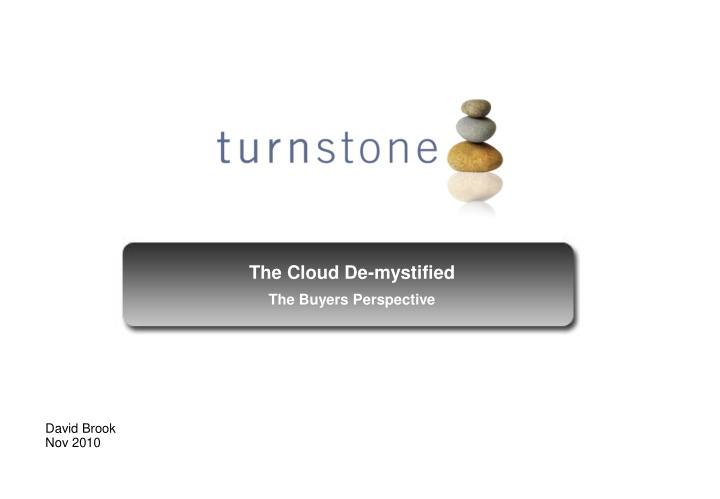



The Cloud De-mystified The Buyers Perspective David Brook Nov 2010
Intro “The leading independent experts in saving IT cost and negotiating safer contracts” Technology Client Suppliers 2
Agenda 1. Types of Cloud 2. SaaS : what’s different commercially? 3. The ‘Take Home’ 3
Types of Cloud Software as a Service SaaS Infrastructure as a Service IaaS Platform as a Service PaaS 4
Why go SaaS? Customer Perspective 1. Low upfront costs - Opex not Capex 2. Flexibility to scale up and down 3. Lower technology running costs Perception it’s easier / more modern? 4. 5. Centralised upgrade / patch management Low exit costs – in theory 6. 1. Data security 7. Technology stays current? 2. Availability 3. Third party dependant 4. Long term higher TCO? 5
Why go SaaS? Supplier perspective 1. Greater profit potential * - If the user base doubles, the suppliers revenue doubles, yet costs only go up a little - Ongoing revenue stream (cf maintenance %) - Direct control of usage limits, rather than relying on software audits 2. Higher risk if customer downsizes Easier sell – can avoid the IT / procurement dept 3. Footnote on Software Pricing Never much linkage between the price of software and their cost to manufacture it “ Cost is real, price is invented” 6
Differences to Normal Software Licencing How do SaaS / Cloud services contracts differ from a standard software licence? In a SaaS agreement you will not usually receive a physical or installed copy of the software. Also no ownership in the software will be transferred to you. You are simply given the legal right to access and use the software for the length of the software licence granted to you. Is a service level agreement (SLA) a software licence? No, it’s more. A service level agreement sets out the services being provided in addition to the right to use the software, namely the hosting, support and maintenance services. This becomes extremely important in a Cloud/SaaS model as the end user organisation is dependant on the supplier for availability, capacity, incident and change management activities that in a traditional model would have been the domain of the internal IT department. Therefore getting the SLA and Service Definitions correct, accurate and fit for the customers individual requirements is imperative. 7
What Replaces The Software License? • Definition of the licence Traditional Software • Costs & payment profile Licence • Delivery, acceptance & documentation • Escrow • Support levels included for faults Traditional • Upgrades included free to maintain the software Maintenance & • Costs Support • Service credits for delay/unavailability • Costs & payment profile • Right to use • Definition of the service, SLA’s • Service credits • Usage costs, banded up and down SaaS Service • Payment terms Agreement • Delivery, acceptance & documentation • Upgrades • Data Escrow + 8
Checklist for Software implementations ... don’t forget • Right to use • Definition of the service, SLA’s • Service Credits • Usage costs, banded up and down 1. SaaS Agreement • Payment terms • Delivery, acceptance & documentation • Upgrades • Data Escrow + • Modifications • Data conversion • Integration 2. Implementation • Reporting • Milestone linked payments • Services & service levels 3. Ad Hoc • Timescales and acceptance Consultancy • Day rates, cost models, volume discounting • Amount and type of training required • Costs for expected and any future training 4. Training • Location and timescales 9
The SaaS and Cloud market What’s available? Products available range from hosted CRM solutions Salesforce.com (Customer Relationship Management) , through email and office productivity to industry specific software. Are people buying it ? Yes. There is more and more uptake of SaaS from large blue chip firms and government organisations with high profile organisations including:- - The Guardian newspaper group using Google Mail and office productivity tools - British Gas using Salesforce.com for CRM - GSK using Microsoft SaaS to supply desktop apps Concerns “ Salesforce's pricing model - costs will only move in one direction — up. The client is a renter and has almost no control over the computing environment. Whereas clients who own their environments can take various steps to reduce costs, including adopting new technologies (virtualization, caching, 64-bit systems), substituting cheaper equivalents for the products they run on (open source, primarily), and outsourcing .” John Rymer, Forrester Research 10
Escrow Past and Present What is it? – A protection mechanism for the customer, if the software supplier goes bust You gain access to the source code. And then... In SaaS world, exact same risk. No guarantee your ‘service provider’ will be around for ever. Protection mechanisms? - Code Escrow – same as above. But practical use even more questionable. - Keep a hot plan B Note: ‘Data Escrow’ is something else, and a ‘no brainer’ for key systems 11
The ‘Global Council for Cloud Services’ 1. The right to retain ownership, use and control one's own data 2. The right to service-level agreements that address liabilities, remediation and business outcomes 3. The right to notification and choice about changes that affect the service consumers' business processes 4. The right to understand the technical limitations or requirements of the service up 5. The right to understand the legal requirements of jurisdictions in which the provider operates 6. The right to know what security processes the provider follows 7. The responsibility to understand and adhere to software license requirements 12
The ‘Take Homes’ 1. SaaS does NOT reduce commercial rigour SaaS Agreement 2. Include all these areas in your tender Implementation Ad Hoc Consultancy 3. Keep and maintain your plan B Training 4. Use data escrow 5. Avoid technical lock in – possibility to re- tender for your major IT systems 13
Questions? “The leading independent experts in saving IT cost Presented by: and negotiating safer contracts ” David Brook David.Brook@turnstoneservices.com Ranked #1 in Google for IT Procurement www.turnstoneservices.com 14
Recommend
More recommend